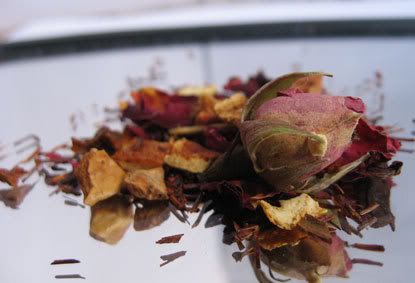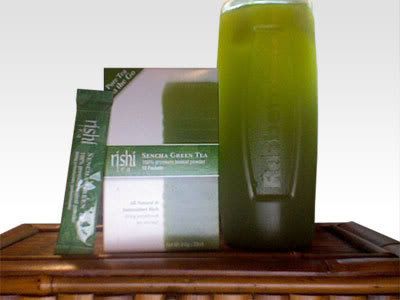"Not so!" says I. "You can't believe how much jasmine teas can vary in both taste and price! The good news is, I'm going to lay it all out straight for you."
So, for the re-inaugeral review, I present a four-part Very Special Episode. Today, we will be sampling four different jasmine teas - they are from the same company, but at different (mostly quite affordable) price points. The aim of this test was to try to explain some of the differences between different types of jasmine tea and why some are more expensive than others, and to see if a cheaper kind can approximate a more expensive kind. Some of us are penniless graduate students (heh) and can't exactly be buying Organic Dragon Phoenix Pearl every single day, y'know?

(From right to left: Flowers, Chung-Hao, Yin-Hao, Pearls)
First, a little background to get us oriented.
Although they're often called green teas, jasmines are very rarely a true green. The leaves undergo some extra steps in the preparation process in which they are scented, and this lets them oxidize a bit more and turns them into a "pouchong" - somewhere between a green and an oolong. (I find most jasmine tea to be more similar to an oolong in terms of flavor experience, as jasmines often lack the grassiness and astringency that green teas have.)
Basically, jasmine teas begin with green or white tea leaves. These are strewn with night-blooming jasmine flowers and left alone for a bit. Because tea is very susceptible to sucking up fragrance (which incidentally is why you should not store it in the fridge), the jasmine flowers infuse the leaves with a beautiful flavor. Then, the flowers are picked out of the tea and new ones spread over it. For a really fine jasmine tea, this can be done over twelve days with seven separate batches of flowers. The result is what's called a "scented" tea, meaning that the tea itself is infused - as opposed to a tea blend that has actual pieces of fruit or flowers left in it, which would be a "flavored" tea. Price points of jasmine range from "highly affordable" to "clobber you over the head and pick your pocket expensive," mainly based on how good the grade of tea was to begin with and how many jasmine infusions it's undergone.
Because I have kind of a biased palette when it comes to jasmine tea (i.e. "it's awesome! All of it is awesome!") I enlisted the help of my partner, Patrick, and my mother Frances for this taste test. I selected four teas - leaving out the most expensive type of pearls, but picking a higher-range pearl, two middling-range greens and a very nicely affordable green with flowers. All four are from Upton Tea Imports, my personal favorite mail-order source for tea and the reason it's possible to have a different kind of jasmine tea every night for a month or so.
JASMINE PEARLS, GUANGDONG PROVINCE
The first tea, and the most expensive of the batch, was Jasmine Pearls from Guangdong Province. These aren't the famous Dragon Phoenix, but they are from the same province and extremely similar, taste-wise, while still a savings of about $10 per 250 grams. (A sample will run you about $3.50.) These guys are the finest preparation of jasmine tea, ever. The whole leaves and buds are hand-rolled into tiny "pearls" after scenting, the same way they've been for the past 900 years. As you infuse the tea, the pearls slowly unfold.
As expected from a costly tea, these have a very light, subtle and beautiful taste. The liquor was substantially lighter than all of the other teas in our jasmine taste test, and the flavor was the most understated - my mom said "From the smell, I expected more jasmine!" The jasmine taste isn't very strong, but it's lovely and floral and not overpowering, letting you taste the quality underlying tea. As we watched the pearls slowly unfold during the infusion time, my mom told me only half-jokingly "That's why they are so expensive, you pay for the show." We tried this tea both hot and iced and it developed a bit of bitterness when cold, but was not unpleasant. Hot, it has no bitterness at all.
The fact is that it's obvious why pearls are the most sought-after type of jasmine tea. If I only had one word to describe the way they taste and smell, it would be "lovely." The tea brewed from these pearls is what I think of when I think of tea - beautiful, soothing and calming. It's difficult for me to even be witty when talking about them, that's how good they are. I'm sure if it came down to the wire, I'd trade a kidney for a cool 250 grams of them.
The goal is for all of us to keep our kidneys, so let's move on to the more affordable jasmines.
JASMINE WITH FLOWERS
This one is a regular-leaf tea, not rolled, with some of the jasmine buds left in the blend for decoration. It's considerably cheaper than the Pearls, $1 for a half-ounce sample.
The first thing we noticed about this one was that the liquor was golden brown and much, much darker than the jasmine pearls. After tasting, however, that wasn't the only difference.
It smelled absolutely fantastic. I don't know how to explain the way the liquor smelled - I wrote on my pad "This is the way tea should smell on a snowy day." I was so enamored of it, I kept huffing my cup. It was just a gorgeous aroma.
Upon tasting, this tea has a nice bitter brightness to it - it's almost coffee-like in that way, you sort of feel like a spoon could stand up in it on its own. It lacks the subtlety of the pearls. However, like the pearls, the jasmine flavor is fairly light, but it's noticeable and pleasant as it adds to the astringent tea flavors but doesn't mask or detract from them. The flavors are less delicate in general.
I like both this one and the pearls for entirely different reasons. This would make a great breakfast tea. It really pops in the mouth, and I felt like the astringency was making my tastebuds stand up and salute. The Pearls might be better for an afternoon or evening tea, but I feel like I'd reach for the less-expensive Flowers first thing in the morning - it seems like a really great tea to banish early morning sock mouth, for one. In fact, this one was my mom's pick for the best morning tea of all four jasmines we tasted.
I thought Flowers would stand up better to being iced, and it does stand up pretty darn well, but ice might make it too bitter for some people. Cooling removed most of the few nuances this tea has to begin with, but it still made a nice, bracing and refreshing cup.
On to the middle-priced selections!
CHUNG-HAO SPECIAL GRADE JASMINE
This tea and the next one, Yin Hao, are made by almost the same preparation and are from the same tea family. Chung-Hao, however, is considerably less expensive than Yin-Hao - a sample of Chung-Hao can be had for $1.50, while a sample of Yin-Hao is $2.50. That's why these are the middle-priced selections, coming squarely between the Flowers and the Pearls.
There are really no visible flowers in the Chung-Hao, but that doesn't mean much. (In my experience, any flowers left in the tea are basically for decoration.) The leaves are fairly small and crushed, and they create a very yellow infusion.
Both the leaves and the infusion smelled SUPER jasmine-y. My mom thought this one was "another good breakfast tea!" and everyone agreed that it "felt smooth going down," which I noted as it having a very pleasant mouth-feel. The taste of jasmine was again subtle, although maybe a bit stronger than both of the previous two teas, and the tea itself was delicate and beautiful like Pearls while still having a slightly stronger quality, like the Flowers.
The general consensus was that if you don't want to pay for Pearls, Chung-Hao is a delightfully affordable substitute that should make you very happy. Some might even like it better than Pearls, as it mimics the flavors well while still being a little more intense, which I enjoy. It's lovely.
YIN-HAO SPECIAL GRADE JASMINE
Again, Yin-Hao is very similar to Chung-Hao, but a bit more expensive - $2.50 the sample. This is the best of the "standard grade" jasmine teas, i.e., the very best of this price range before you move into the Pearls.
The leaves smell extremely floral, and they're dark - quite a bit darker than all of the other jasmines in the taste test today. Upon tasting, I wrote on my pad "All jasmine, all the time!" which for me is an excellent thing - this tea definitely has more of an intense jasmine flavor than all of the others, but it still isn't too much, and doesn't mask or conceal the flavors of the tea. The tea flavor and the floral flavor are perfectly balanced. The aftertaste is exceedingly jasmine-y as well, in a pleasant way.
My notes say "The smell is AWESOME!" I wish I had elaborated, but I didn't, so there you go: the smell was awesome.
This one had a great mouth-feel, unsurprisingly similar to the Chung-Hao. It was strong but very smooth without any hint of bitterness whatsoever.
We put it over ice and it was absolutely gorgeous. It was definitely the clear winner as far as iced tea was concerned, with a lovely vegetal array of flavors and an enticingly sweet aftertaste.
The consensus was that this wasn't very similar in taste to the Pearls or anything except its cousin Chung-Hao, but we actually preferred the balance of flavors in Yin-Hao to the Pearls. Over ice, there really wasn't any comparison between the two - and pricewise, you're looking at a 40%-50% decrease at higher volumes of purchase.
CONCLUSIONS
Nothing, alas, will stand up adequately to Pearls, and that is for a reason. They are an art form of tea, the ultimate in jasmine perfection. But if you really like jasmine and don't want to spend lots of money, there are plenty of opportunities for you. Even the cheapest of the teas we sampled was delicious and had its own notable features, and these are by no means all of the affordable jasmines that are available out there.
* If you like the taste of Pearls but don't want to pay for them, try the Chung-Hao Special Grade.
* If you like a stronger jasmine flavor, pick up Yin-Hao Special Grade.
* If you want iced jasmine tea, pick up Yin-Hao Special Grade.
* For a nice morning green tea, try Jasmine with Flowers or the Chung-Hao Special Grade.
Notes: I'm not going to give these leaf ratings because I liked them all for totally different reasons, so it would be entirely arbitrary. I will, however, encourage you to try all of them, and tell you that I know Yin-Hao is going to be the one I reorder most often.

On a final note, this post is in memory of my little cat, Jasmine, who had to leave to go to Kitty Heaven a few weeks ago at the ripe old age of 16. I love you and miss you, kitty.







